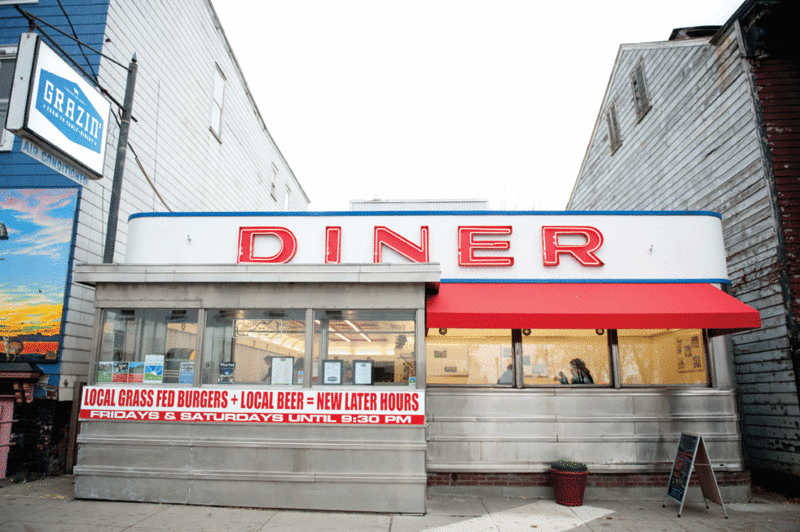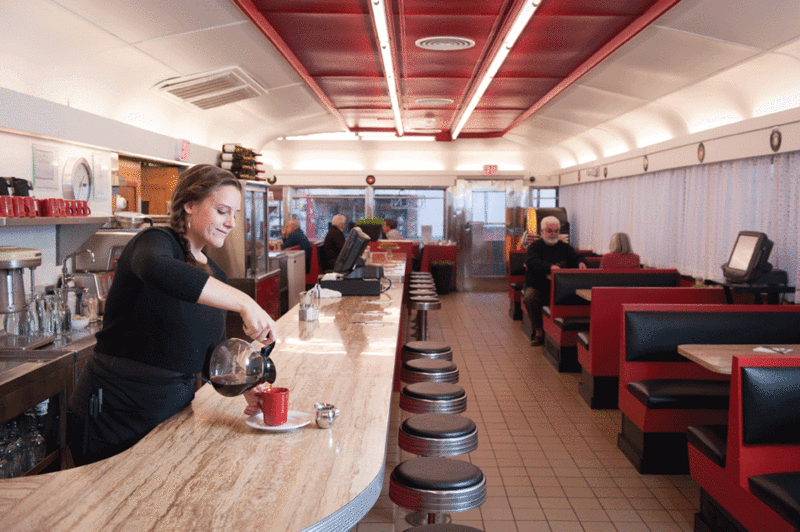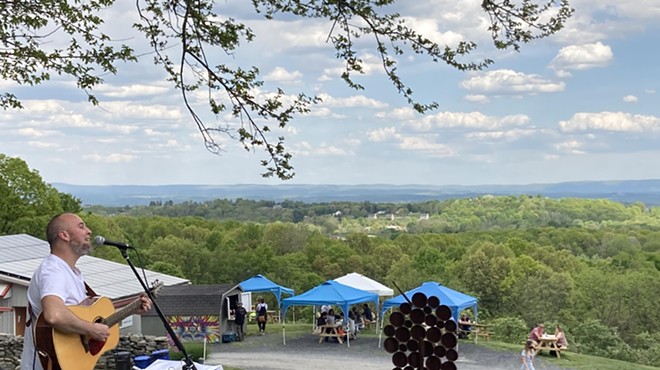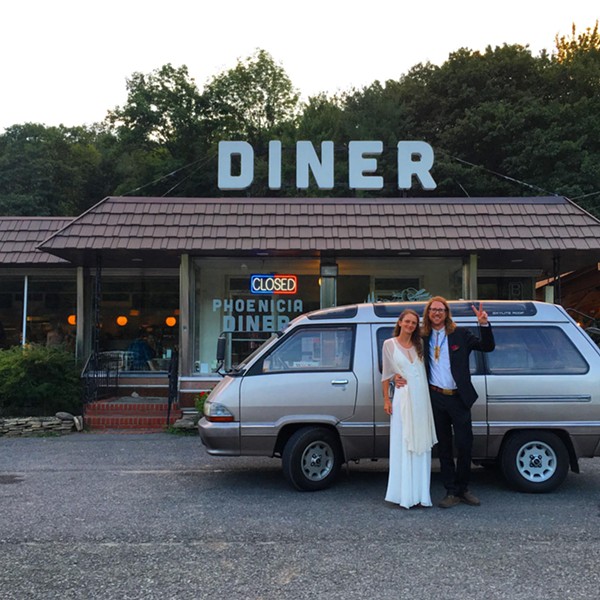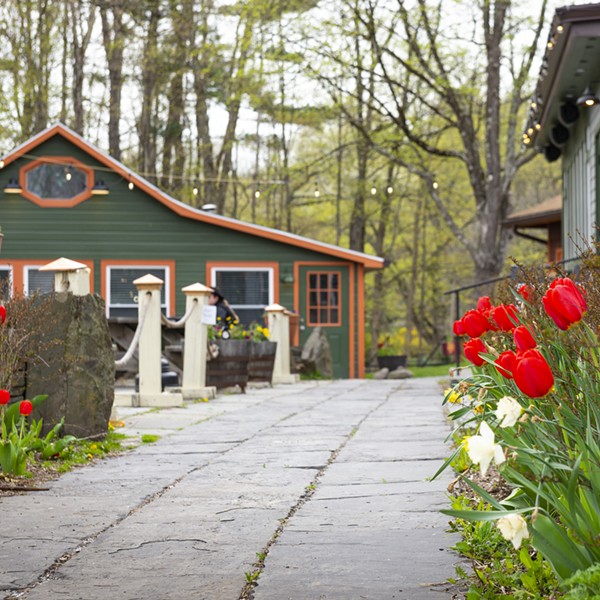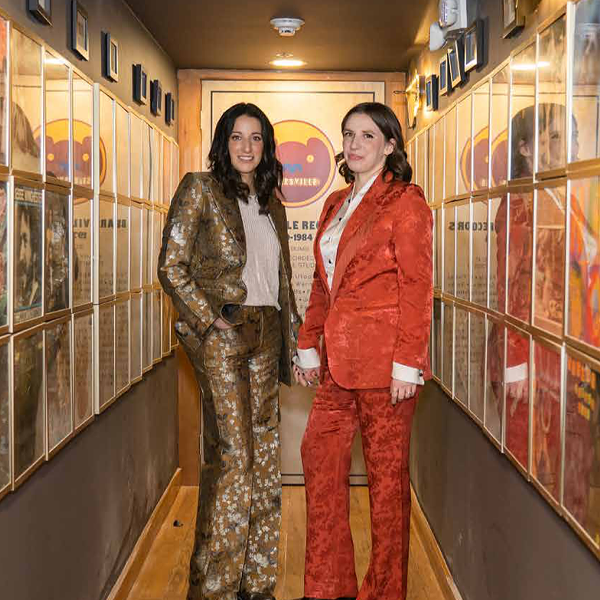Just as most marriages depend on a firm grasp of football trivia, diner food relies on our enduring national appetite for affordable, comforting fare. It’s not normally a cuisine that we associate with the sort of refinement (and price tag) that often attends the farm-to-table label. And while the upper echelons of the market drive food trends that eventually become ubiquitous (sun-dried tomatoes, anyone?) it’s vitally important that local eating be inexpensive and demotic enough for all to partake. Enter Grazin’, a diner with impeccable locavore credentials.
“It’s a sound concept, and we’re really proud of it,” says the 35-year-old manager and cook Andrew “Chip” Chiappinelli. “I want you to come in and enjoy the food, but I also want you to care about the sourcing.” Almost all the ingredients come from within a dozen miles of the diner. Chiappinelli grew up in his CIA-trained Father’s Italian restaurant in Westchester. “Some of my earliest memories are of standing on a milk crate doing dishes because someone called in sick, or of layering eggplant in the parmigiana.” Despite his culinary upbringing, he says he never imagined running a restaurant until his Parents-in-law Dan and Susan Gibson persuaded him and their daughter Christine to relocate and work with them.
The Gibsons own Grazin’ Angus Acres, a grass-fed cattle farm in nearby Ghent. “They kept asking me ‘when are you going to move back up here with our daughter?’” After a decade working as a corporate IT director in Manhattan, and wanting to start a family, Chiappinelli says it finally seemed like a good idea. He went to work as the sales rep for Grazin’ Angus, running the greenmarket stands in New York City for two years before they decided to buy the Columbia Diner on Warren Street in Hudson earlier this year. The restaurant reopened as Grazin’ in October. Built in 1946 (assembled, actually, from two halves that came up the river from New Jersey on barges), the classic structure has all the chrome and formica that one requires from such an establishment, and a large jukebox, playing a steady stream of vintage rock, greets visitors as they enter.
The endeavor got off to a rocky start; eleven days before opening, the cook quit, so Chiappinelli was interviewing new candidates with just a few days to go. During a soft opening for friends and family, which Chiappinelli describes as “a disaster,” their plumber suggested that they hire his daughter, Amanda Finkle, who now works alongside Chiappanelli in the kitchen. “She had experience cooking grass-fed beef, and we think about food the same way,” he says. “We’re a burger joint, and she can really cook a burger.” Grass-fed beef has a narrow margin for error, and overcooks easily, so servers encourage customers to try eating meat one shade pinker than they’re used to. “We’re always a little sad when we see orders for well-done,” Chiappinelli says; “really good, clean beef has no business being gray all the way through. This beef was raised in my back yard.”
“I’m not sure it would be the same place if I hadn’t spent the two years learning about animals and humane farming,” he continues. “I became a zealot about raising animals the right way.” As a result, Grazin’ is the first restaurant in the country to be certified as Animal Welfare Approved. AWA is the most comprehensive and transparent certification available; farms must be small, independent, and family-owned, and the requirements for feed, housing, pasture, and veterinary care are detailed and extensive. Every animal product served at Grazin’–meat, eggs, and dairy–comes from an AWA certified farm. Chiappinelli explains that this limits the amount and number of products they can serve: “We don’t have bacon for Sunday brunch because we can’t get enough of it, so we make our own pork sausage and offer that instead. Organic means nothing with meat; it only means the cows’ grain is organic, not that they have pasture or any quality of life. And beef is about grass, not grain. ‘Certified Humane’ isn’t much better, because it was created by big ag for big ag, and it costs the farmer a lot to get certified [as does organic]. AWA doesn’t charge for their certification.”
The burgers are pleasantly irregular in shape, as are the fries, which still have skin on them: all obvious signs of their handmade nature. The burgers are juicy, with the characteristically beefy flavor of grass-fed meat, and come plain or with several combinations of toppings: blue cheese and caramelized onions, homemade chipotle mayo with bacon and spicy relish, or country ham, cheese, and a fried egg. The fries are a little too dark and a little too soft, and could benefit from double frying, which is the best way to get crispness without overcooking. Small jelly jars of ketchup come alongside to minimize waste, and all kitchen trimmings and scraps go the pigs back on the farm. The kitchen crew makes butter and mayonnaise weekly, and Chiappinelli pickles the seasonal vegetables that come with each burger or sandwich. And yes, there are a couple of vegetarian options.
There are some challenges with such rigorous sourcing, though; Irene flooded the farm where they planned to get tomatoes and potatoes–all the Kennebecs intended to be turned into fries were lost–so Chiappinelli had to work with a distributor instead. He laments: “It sucks, but I don’t have much of a choice.” He’s debating whether to leave tomatoes off the menu until next summer. There are imported exceptions, of course: oranges for fresh-squeezed juice at Sunday brunch, spices, and coffee, among others. But they’re almost exclusively organic or biodynamic. Chunky, retro thick-sided red coffee cups hold a seasonal, organic, fair-trade blend from Strongtree, just down the road. Beans are for sale at the diner for regulars who can’t get enough.
The limitations inspire, however, since they require improvising on short notice; Chiappinelli has used leftover challah for bread pudding at brunch, for example, and is always thinking of more things he can make in-house. He has big plans for the largely unused basement. Hawthorne Valley, the biodynamic farm and school in Ghent, bakes their buns and bread, and supplies quark, milk, and cheeses. (Other cheeses come from AWA certified farms in New York and Vermont). The occasionally erratic supply chain also demands adaptability: Chiappinelli excuses himself mid-conversation to run out to the farmers market and pick up a box of fresh mesclun because the farmer’s truck broke down.
Something Chiappinelli is particularly proud of is the soda fountain. “You can’t get a coke here,” he boasts, explaining that they buy organic cream soda, cola, and birch and root beer extracts from Illinois and then add organic sugar syrup and carbonated water on site. The sodas taste bright, complex, and detailed, much as the original formulations must have a century or more ago. Drinking them is like converting a black and white movie to high-definition color. The cola has many distinct flavor notes—citrus, cinnamon, anise, ginger, lavender, vanilla—that reveal its origin as a medicinal tonic. It’s a sweet treat for kids, and offers some thought-provoking beverage archaeology for adults. The birch beer has a classic sasparilla profile, with some wintergreen added for extra interest. And the sodas are all clear, reminding us that caramel color is just another superfluous fluid. There are two flavors of house-made ice cream: vanilla and cinnamon, which are deployed neat, in root beer floats, or to top the apple and pumpkin pies currently on offer.
As with the soda fountain, the burgers also accurately represent how American food used to taste. Before the industrialization of the food system, one would have eaten grass-fed beef on a locally baked bun because that’s how everyone in this country ate. And this gets to an important part of the locavore phenomenon: at its core, it’s fuelled not by righteous snobbery or moral rectitude but by the quality of the sensual experience. Local food tastes better. And when you pay ten or twelve dollars for your burger, you know where that money is going, and that you’re paying the full cost of the food; there aren’t any ocean dead zones or antibiotic-resistant bacteria at the other end of your food supply. Conservatives who pine loudly and often for the Good Old Days™ and the free market should eat this food.
Others in the region are working in a similar vein: the Oakhurst Diner in Millerton and Rusty’s in Red Hook are both making affordable standards with local ingredients. Chiappinelli concludes by saying “Dan wanted to open a restaurant because there was nowhere for us to eat around here, since we don’t eat factory-farmed meat.” Ultimately, though, the best thing about Grazin’ is that whether you’re a devout locavore or just want to enjoy an excellent burger, it’s friendly, accessible, and enjoyable. It’s a smile.
Peter Barrett indefatigably documents what one man can cook, given the time,
ingredients, and imagination, at www.acookblog.com.

Jennifer May
The “Uncle Dude†hamburger at Grazin’ in Hudson: with house-made chipotle mayo, Hawthorne Valley Cheddar, GAA Bacon, jalapeno relish, fresh greens, tomato and raw onion. Milk shake made with organic house-made chocolate sauce and house-made ice cream from grass-pastured cows at Milk Thistle Organic Farm in Ghent







